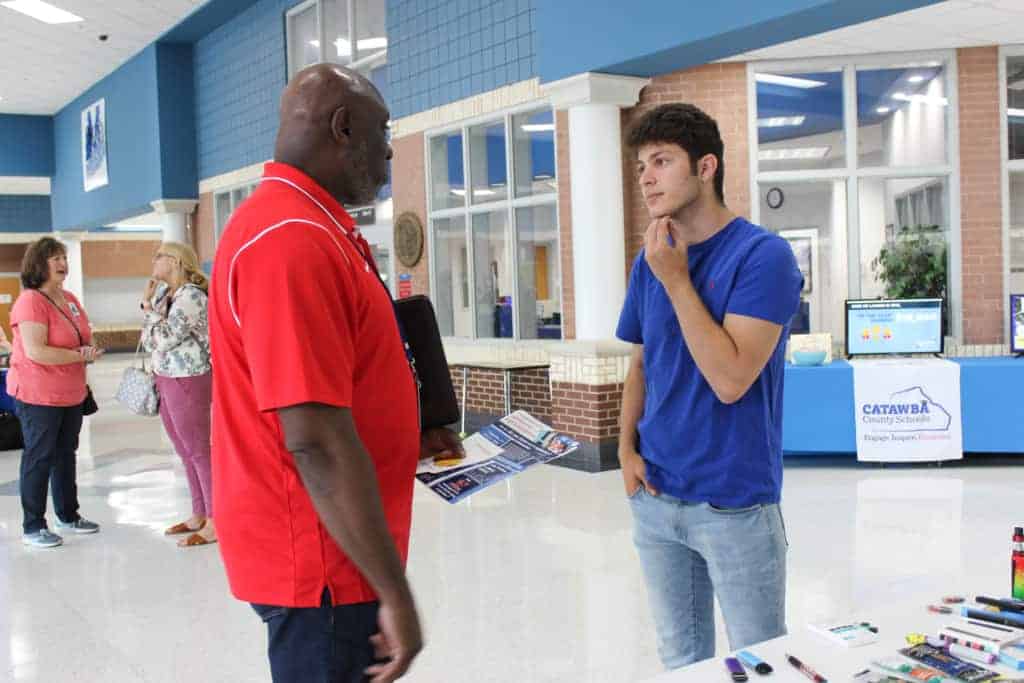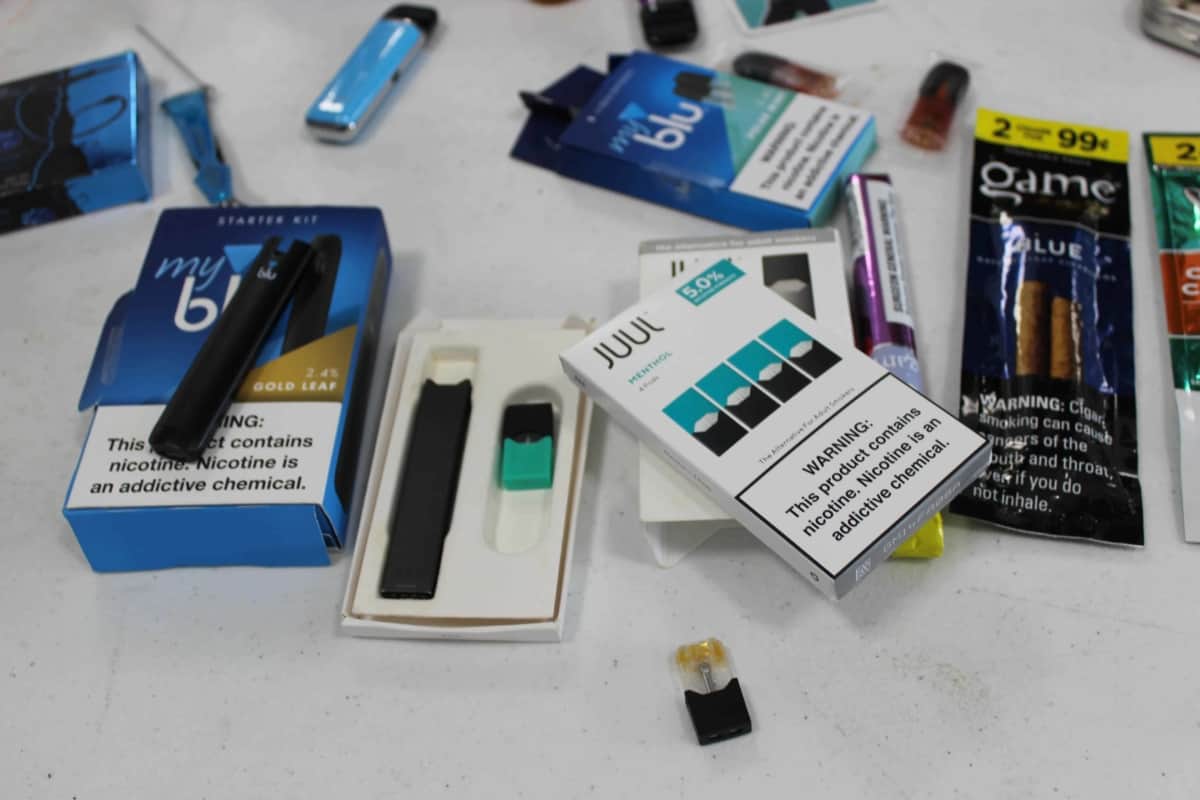On Aug. 15, 120 middle and high school faculty from Catawba County Schools gathered in the Maiden High School auditorium for an information session on vaping. The session, which was part of the district’s four-day Modern Classroom Conference, featured the region’s tobacco control manager, Carleen Crawford, and Kelly and Luka Kinard — a mother and son duo who have traveled the country sharing their story after Luka became addicted to Juul.
Crawford’s comprehensive presentation included a background on the dangers of tobacco products, examples of the evolution of vaping products from larger devices to the sleek and popular Juul, and the impact of vaping on youth.
Crawford also shared photos of more recent products teachers should be aware of. As she shared a slide of a hookah pipe bracelet and hoodies with drawstrings designed to conceal vapes, whispers went through the surprised crowd. One of the companies creating these products is named VAPRWEAR and describes itself as “all about convenience and discretion.” Making teachers aware of products like VAPRWEAR comes on the heels of administrators dealing with what the Food and Drug Administration termed an “epidemic” of e-cigarette use among youth. The 2018 National Youth Tobacco Survey found that 1.5 million more students used e-cigarettes in 2018 than in 2017.
A growing number of youth addicted to nicotine
“You out in the schools, in the trenches, are probably seeing this now,” Crawford said of the epidemic that has drawn in youth through advertising, flavors, and nicotine. When Juul’s popular pods (e-liquid cartridges) came on the market, they carried 5% nicotine — twice the amount of nicotine than other e-liquids. It’s estimated that one Juul pod has roughly the same amount of nicotine as one pack of cigarettes. After backlash to these high levels of nicotine, Juul Labs responded by releasing a 3% nicotine option made widely available last October.
Crawford explained that products like Juul are formulated with a nicotine salt blended with benzoic acid that allows for a much smoother intake.
“So it’s a bigger hit, smoother intake,” she said. “That’s why we’re seeing kids become addicted quickly.”
Another factor in young people vaping more is an attraction to flavors. Last year, Juul pulled several of its flavors deemed attractive to youth from retail, like mango. However, since then, other products and even counterfeit Juul pod products have hit the market. Juul Labs gets more attention for the youth epidemic because of its larger share of the vape market at more than 70% — but they are far from the only vape products around. Other flavored e-cigarettes attractive to youth include Suorin, Phix, and Bo. Using sales to compete with Juul, e-cigarette brands NJOY and Vuse promoted their e-cigarettes for 99 cents.
With a market of flavored nicotine products, more young people have become addicted to using them. Crawford shared signs and symptoms of nicotine addiction in youth, including irritability, anger, difficulty concentrating, and changes in eating patterns. Some of these symptoms are highlighted in an awareness campaign created by Tobacco Free California, seen below.
The audience in Catawba, however, had the chance to hear directly from a previously nicotine-addicted teen, Luka Kinard. Kinard, a high school student from High Point, has been open about his story and shared his experience with schools and anti-vaping programs across the country.
He told the audience how he first started vaping to fit in with the upperclassmen at a football game, and how he was told the products were just “vegetable oil.” He had no idea of the nicotine content of the Juul he was using, and soon he went from a single pod to four pods a day (four pods is a full pack of Juul pods). He would go through an entire pack per day for months.
“That’s absolutely outrageous to think about the amount of nicotine I was taking in,” Kinard said.
What had first become a way to fit in turned into the “one consistent thing” he had for coping with stress. But then it started to affect his personality. He quit sports, quit Boy Scouts, and experienced failing grades for the first time. He would continuously argue with his parents.
“Everything that I loved I had completely stopped and lost interest in,” he said. “It became ‘I want this nicotine. I want my fix.'”

Then, last September, Kinard had a seizure. It turns out he wasn’t alone. Earlier this year, the FDA launched an investigation into the link between vaping and seizures.
It was the turning point for Kinard and his parents. Even after seeking counseling, the family was unable to get a diagnosis for nicotine addiction. Instead, his mother — after much searching for appropriate treatment — found an adolescent treatment program in California, and Kinard was sent to rehab for 39 days.
In her talk, his mother, Kelly Kinard, remembered the months of her son’s nicotine addiction. (Read more of Kelly Kinard’s story here).
“He didn’t have the will to quit,” she said. “He saw no problem with what he was doing. As he saw it, we were the problem.”
Three weeks after his return from treatment, Kinard said she started to finally hear some of the son she knew again.
“No school in this country is immune to this epidemic,” she said of the ordeal she experienced. “The sooner they quit the less damage they do their lives.”

Schools and communities take a stand against vaping
Maria Ballard, director of student services for Catawba County Schools, moderated a question and answer period at the end of the session. One of the questions that came up was around punishment for students vaping in class.
The Kinards and Crawford shared support for in-school suspension along with a vaping education component rather than out-of-school suspension.
“If you suspend a kid for three days, or however long, what are they going to do for those three days?” Luka said. “They’re going to vape.”
Ballard agreed that additional supports were needed for students.
“Punishing is not the answer,” she said. “It does not help solve the problem.”
However, the school system did decide to specifically update the student code of conduct to address vaping:
“Students are prohibited from possessing, using, smoking, inhaling, chewing, dipping or otherwise consuming any tobacco product, nicotine or other chemical and from possessing or using tobacco paraphernalia, electronic cigarettes, vapes or other devices which allow a person to inhale tobacco, nicotine or other chemicals,” the code of conduct says. “The term ‘tobacco paraphernalia’ shall include, but is not limited to, rolling papers, matches, and lighters and electronic cigarettes, vapes or other devices which allow a person to inhale tobacco, nicotine or other chemicals.”
The policy falls under the school’s Class II Violations, which “may result in disciplinary action to the student as determined by the school administrator” and can include in-school detention or out-of-school suspension for less than or equal to 10 days on first offense.
Statewide, there has been an effort to increase knowledge that a “tobacco free campus” includes vape products. This year, images of e-cigarettes have been added to tobacco-free signs.
In addition to the school system taking a stand on student vaping, municipalities have also joined in on keeping their towns vape-free. Earlier this year, the Maiden Town Council voted unanimously to ban smoking and vaping in all public parks.
Recommended reading




